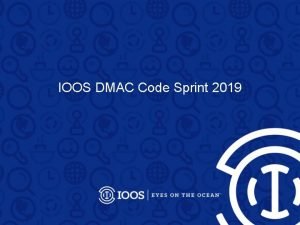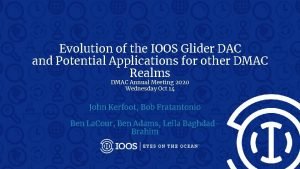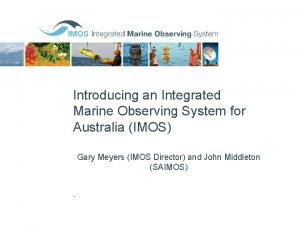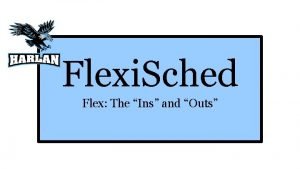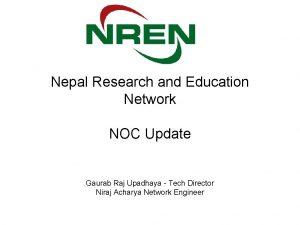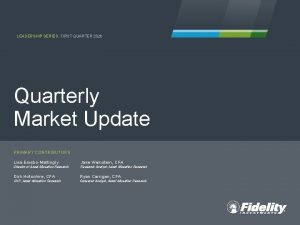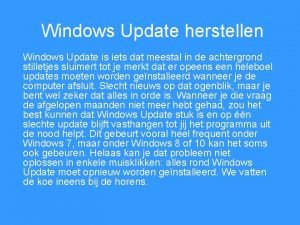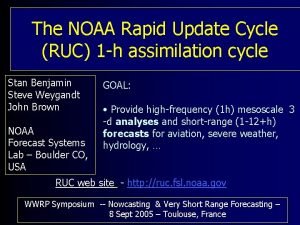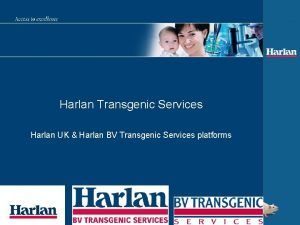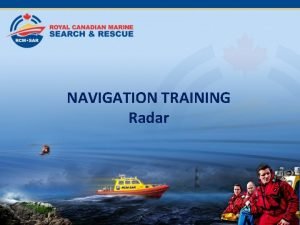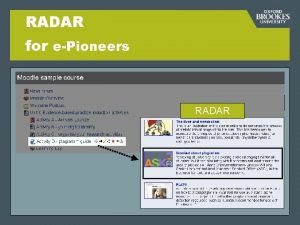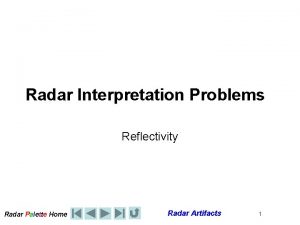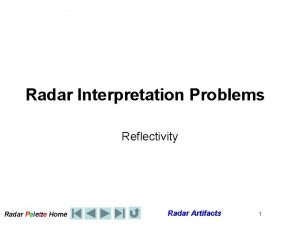IOOS National HF Radar Update Jack Harlan IOOS













- Slides: 13

IOOS National HF Radar Update Jack Harlan IOOS National HF Radar Project Manager GCOOS Annual Meeting September 2012 Corpus Christi

US IOOS HF Radar Network - 129 Radar Sites - 29 Institutions - Redundant National Data Servers - Common Data Format

HF Radar Topics • Radio Frequency Licensing • 2012 Technical Steering Team Outcomes • National Projects

Radio Frequency Licensing • International approval of IOOS proposal during World Radiocommunication Conference (Geneva Jan-Feb 2012) • Two technical issues to be resolved: – Call Sign Identifier every 20 minutes – Band sharing and synchronization • All HF radar frequencies used in US can continue as before (except possibly 8 MHz WERA due to objections from S. America)

National HF Radar Technical Steering Team • Established Spring 2010 • 6 reps elected from all RCOOSes • Volunteers from Federal agencies, academia, private sector • Inaugural Mtg: July 2010 • Annual Meeting • Larry Atkinson (Old Dominion Univ. ) • Don Barrick (Codar) • Bill Birkemeier (US Army Corps of Engineers) • Pat Burke (NOAA CO-OPS) • Dick Crout (NOAA NDBC) • Pierre Flament (Univ Hawaii) • Scott Glenn (Rutgers Univ) • Ming Ji (NOAA OPC) • Mike Kosro (Oregon St Univ) • Jeff Paduan (NPS) • Rich Patchen (NOAA/CSDL)* • Nick Shay (Univ Miami) • Eric Terrill (Scripps) *retired

2012 Steering Team Outcomes • White Papers posted at ioos. gov/hfradar – HFR-Derived Waves – HFR Operation in Freshwater • • Annual report from Steering Team Forge relationships with WFOs Beta testers of new vendor software Adapt & extend existing network monitoring tools (underway) • Continue modeling/data assimilation Tiger Team

2012 Steering Team Outcomes • Modeling Testbed FFO – Trajectory tool – HFR data assimilation & modeling • Recognition of HFR Technicians

National HF Radar FY 13 Projects • HFR data into AWIPS at WFO’s – NDBC is Technical Lead – IOOS is Programmatic Lead – NWS Office of Science & Technology is coordinator • HFR data into PORTS® – IOOS working with CO-OPS

GEO Global HF Radar • Effort to develop & promote HFR – Sharing best practices – Common data formats – Ingest & Display global HFR data – Meshed with NOAA-Korea agreement to provide data ingest & display of Korean data; to provide best practices exchange with Korea

Ioos. gov/hfradar Jack. harlan@noaa. gov

Backup Slides

Specific HF Radar Guidance • This funding will sustain existing systems, ensuring they have reliable operations and maintenance support, and network-wide investments will continue to improve quality assurance and quality control methods, data management capabilities. • The funding will also allow for the completion of assessments to prioritize highest priority gaps in coverage. • HFR will be implemented as a Federal and non. Federal partnership through the Regional Coastal Ocean Observing Systems and Federal operational data centers including the National Data Buoy Center and the U. S. Coast Guard’s Environmental Data Server.

Specific HF Radar Guidance (cont. ) • Guidance from the Administration is to focus on the existing HFR network and regions of offshore oil production and in the vicinity of major ports and harbors.
 Which is an alternative of log based recovery
Which is an alternative of log based recovery Pulse doppler radar vs mti
Pulse doppler radar vs mti Difference between pulse doppler radar and mti radar
Difference between pulse doppler radar and mti radar Ioos code sprint
Ioos code sprint Ioos
Ioos Ioos
Ioos Main characters in jack and the beanstalk
Main characters in jack and the beanstalk Harlan flex bell schedule
Harlan flex bell schedule National unification and the national state
National unification and the national state Noc update
Noc update Fidelity quarterly market update q1 2018
Fidelity quarterly market update q1 2018 Windows update herstellen
Windows update herstellen Is cookie countable or uncountable
Is cookie countable or uncountable Replace
Replace



